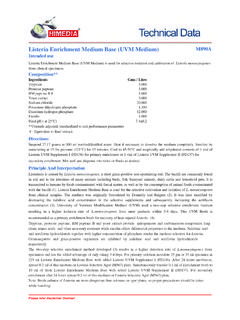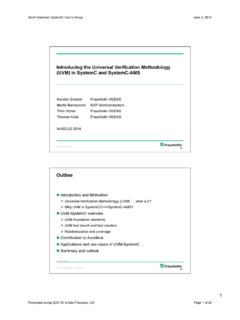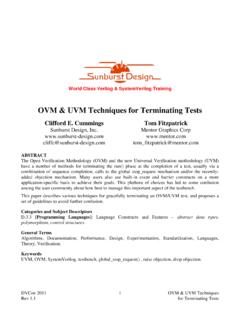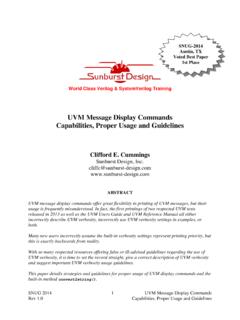Transcription of Advanced UVM Register Modeling - Verilab
1 Advanced UVM Register Modeling There's More Than One Way to Skin A Reg Mark Litterick, Marcus Harnisch Verilab GmbH. Munich, Germany Abstract This paper provides an overview of Register model environment with alternate stimulus, or where registers are operation in the UVM and then explains the key aspects of base updated from internal sources such as an embedded class code that enable effective complex Register Modeling . microcontroller. For passive Modeling the standard access Several possible solutions to common Modeling problems are hooks suggested by UVM documentation are inappropriate and discussed in detail with a focus on supporting both active and the implementer needs to make use of alternative callbacks. passive operation. In addition the performance impact of large Register models is analyzed and improved solutions provided. C. Performance Keywords UVM, Register -Model, Register -Performance In a typical complex System on Chip (SoC) device we can easily have tens of thousands of Register fields in the model.
2 If I. INTRODUCTION we follow the standard guidelines for factory generation as proposed by the UVM we suffer from a significant load and Writing effective Register models for most complex designs build-time performance penalty. The paper observes that since involves Modeling any number of imaginative Register field Register models are generated to-order from the documentation operations, side effects and interactions between different source, it is not part of the standard use-case to perform factory registers . The Universal Verification Methodology (UVM) overrides on registers or fields. We demonstrate what the provides a standard base class libraries that enable users to factory overheads are and provide alternative guidelines on implement just about anything the designers can dream up, but how to minimize Register model overhead without the documented examples, recommendations and guidelines compromising usability.
3 In addition we also explore the are misleading and can result in ineffective implementation and possibility to build registers on-demand. poor performance. This paper provides a brief overview of Register model II. UVM Register OVERVIEW. operation in the UVM and then explains the key aspects of In a verification context, a Register model (or Register base class code that enable complex Register Modeling , abstraction layer) is a set of classes that model the memory- including: mapped behavior of registers and memories in the DUT in order to facilitate stimulus generation and functional checking A. Multiple Solutions (and optionally some aspects of functional coverage). The By presenting and analyzing multiple possible UVM provides a set of base classes that can be extended to implementations for several Modeling problems, we are able to implement comprehensive Register Modeling capabilities as present the user with a clear understanding of what patterns are detailed in [1] and [2].
4 The fundamental structure of the actual more appropriate to specific applications and why. From this Register model is illustrated in Figure 1. analysis we derive guidelines on when it is appropriate to use callbacks, when custom fields are required, and illustrate the use of dynamic field access policies. B. Passive Operation The basic UVM Register model application programming interface (API) is very stimulus-centric. In particular the user is presented with the opportunity to customize derived fields using pre/post read/write hooks in the base field class and associated callbacks. As a result many Register models are built up using hooks that do not result in correctly modeled Register behavior in a passive context, under any circumstances when the Device Under Test (DUT) Register receives stimulus that was not a direct result of running a corresponding Fig.
5 1. Register Model Structure sequence on the Register model; typically passive reuse in an Copyright 2014 Verilab & DVCon 1. The Register model itself is a set of DUT-specific files that extend the UVM base classes. Due to the number of registers required and their regular structure, the model files are usually generated from a textual Register description source (such as XML) in parallel with the generation of actual RTL for the DUT registers . The top-level Register block is instantiated in the verification environment in parallel with other interface verification components, as shown in Figure 2. Fig. 3. Access Paths for Active and Passive Operations Another form of passive operation is when the Register model is used in an environment where the stimulus is provided by some other mechanism entirely (such as executable software, or a legacy non-UVM environment), but the model is still required to be accurate for checks and functional coverage.
6 For actual bus traffic from an alternative source to be observed, a predictor must be present on the corresponding bus hierarchy. The UVM Register model API is Fig. 2. Environment with Register model, adapter and predictor very stimulus-centric and the documentation is focused on the active usage of the class constructs, which leads to confusion in Note that the reusable interface components do not contain partial and fully passive contexts. a reference to the Register model (since this would compromise It is not just the field Modeling aspect that needs to be portability), but the enclosing environment implements any aware of passive usage, but also any checks that make use of required interaction between the interface components and the the Register model state. For example implementing Register model. The main interaction between the Register model and checks using the mirror method in a sequence (which reads the the rest of the verification environment is via adapter and Register and checks the mirrored value against the read value) is predictor components: not portable to a vertical reuse scenario; so monitors should be uvm_reg_adapter converts between Register model read used to implement passive checks instead [4].
7 And write methods and the interface-specific transactions B. Predictable and Volatile Modeling uvm_reg_predictor updates the Register model based on observed transactions published by a monitor The accurate Modeling of all Register fields in the DUT. goes beyond the capabilities provided by the Register model A good introduction to Register model usage and how to set constructs, since many Register fields are modified by the DUT. up the adapter and predictor is provided by [3]. in response to alternative stimulus and not just bus operations. Such Register fields are not predictable, based only on A. Active and Passive Operation described behavior in relation to read and write operations, and The UVM Register model supports both active and passive are termed volatile from the model viewpoint. Typically these modes of operation and is often used in an environment where registers are not checked directly by the model, but rather the both are required as shown in Figure 3.
8 In an active context, RTL value is probed using active monitoring via the specified Register operations are sourced via the Register model read and HDL path ( the actual path to the RTL Register field in the write methods, which in turn get converted to sequence items DUT), in order to keep the field up to date [5]. This means the for an interface verification component via the adapter (path 1 model adapts to DUT behavior and additional external checks in Figure 3). Passive operation refers to any Register operation should be used to validate that the DUT field, available in the where the stimulus did not explicitly use the Register model Register model, has the correct value under all circumstances access methods directly, for instance if an interface component dictated by the specification. In some cases it may also be sequence is executed directly by the virtual sequencer without possible to model status registers as read-only but non-volatile, calling the Register model access methods (path 2 in Figure 3), and analyze external stimulus directly to predict new Register or if the Register content is affected by a bus transaction from values based on observed events.
9 An alternative stimulus source, for example an embedded CPU Modeling and checking volatile Register behavior in the running firmware (as shown by path 3 in Figure 3). larger context is non-trivial, but is part of the overall verification environment Modeling responsibilities. For instance, how do we validate that the resultant value on a volatile Register bit is correct if both the bus and the hardware try to update the bit at the same time? Which operation has priority and has that been implemented correctly in the DUT? More fundamentally, what external stimulus should cause the Copyright 2014 Verilab & DVCon 2. volatile Register field to be updated to a particular value and distinction between the two main mechanisms, hooks and when may this occur deep inside the design? A full analysis of callbacks, which are used to affect Register model behavior.
10 All aspects of volatile Register field Modeling in the context of Register and field base classes provide a set of empty functional behavior of the application is outside the scope of this paper; the remaining sections focus on maintaining an virtual method hooks (pre_write, post_write, pre_read and post_read), which are called at specific points in the execution accurate model of non-volatile Register fields. of the Register operations. The Register model developer can implement one or more of these methods in the derived class in III. Register MODEL OPERATION order to affect the functionality. This is normal object-oriented behavior and nothing to do with the callback mechanism. A. Register Access API. class my_reg_field extends uvm_reg_field;. An overview of the Register and field access API is .. provided by [1], with a more detailed explanation provided by virtual task post_write(uvm_reg_item rw).







